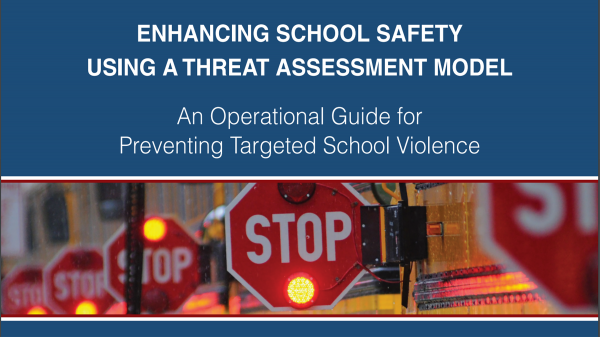Terrorism Task Force Takes On School Safety

The cover of the report “An Operational Guide for Preventing Targeted School Violence.” US Secret Service
Last week, the U.S. Secret Service released a guide for preventing school violence. Issued in response to recent massacres in Parkland, Florida, and Santa Fe, Texas, it’s subtitled “An Operational Guide for Preventing Targeted School Violence.”
But closer to home, a group from the Illinois Terrorism Task Force had already presented a very similar set of recommendations back in April.
This group, known simply as the “school safety working group,” is led by Mike Chamness. His tenure with ITTF goes back to its founding in 1999 — predating the 9/11 attacks. He convened this school safety working group just a couple of weeks after the Valentine’s Day school shooting rampage in Parkland, Florida.
From the get-go, the school safety group’s target was limited.
“We were looking for recommendations that avoided getting into the political quagmire of gun control and things like that,” Chamness says, “but practical recommendations of things that incrementally might make schools safer.”
For example, one recommendation suggests that schools protected by sprinkler systems should consider switching to a two-part fire alarm. After the initial alarm, staff would have up to three minutes to assess if there’s an actual fire, or if the alarm was pulled by a shooter trying to lure students out of classrooms.
“We recommended that that’s something that districts and fire chiefs should take a look at and consider protocols, because the world has changed in terms of, if you pull a fire alarm and you immediately evacuate a building, that might not be the best thing to do,” Chamness says.
That's a pretty novel idea. But the plan mainly focuses on more conventional measures, such as establishing Behavioral Threat Assessment Teams, which also form the centerpiece of the Secret Service guidelines. The federal version (which hadn’t been published when Chamness’ group crafted their plan) says these teams should include an interdisciplinary collection of teachers, counselors, coaches, school resource officers and administrators. The Illinois version specifies law enforcement officers, mental health professionals and other disciplines "as needed."
Such teams were mandated for colleges and universities more than a decade ago, in response to a shooting at Virginia Tech, when 27 students and five faculty members were killed.
Jantzen Eddington serves on the threat assessment team at the University of Illinois Springfield, where he’s the acting Dean of Students. When asked to describe the Threat Assessment Team, he consistently refers to it in tandem with a softer approach.
“We have two teams at the university,” he says. “We have the Campus Behavioral Intervention Team, and then we also have a separate threat assessment team.”
That first team, which he calls CBIT, was formed in 2006 — a year before the Virginia Tech massacre. Comprised of administrators and professors, part of its mission is to assist students in crisis by hooking them up with appropriate campus services (counseling, academic support, social connections) before their personal crisis morphs into something larger.
“CBIT tries to put out a fire before it starts, is how I maybe would describe it,” Eddington says.
What he’s learned, in 12 years of working with college students, is that there’s no easy way to predict which students are in crisis.
“Sometimes, students who we talk about in CBIT are the students who have not made many (social) connections; sometimes they aren’t. Sometimes they’re students that we’ve all had some interaction with,” he says. “So students can be in crisis at any level of social interaction.”
The Threat Assessment Team handles actual threats. The two teams share some of the same staff members (such as the campus police chief), but he doesn’t lead either team.
“The chief — he participates, advises and gives support, but these are not directed from a law enforcement perspective,” Eddington says.
Conversely, the plan Mike Chamness and his group have drafted for k-12 schools is mostly from a law enforcement perspective. Of its 22 members (all but two of whom are male), roughly half have law enforcement backgrounds, while only six members have any history of direct experience in k-12 education.
The working group doesn’t include anyone from Chicago Public Schools, but Chamness says he consulted several times with the district’s security chief, Jadine Chou. She lowered the CPS’s suspension rates substantially by having her entire staff trained in restorative justice and de-escalation techniques. “I felt like I had her input to carry to the task force,” Chamness says.
Much like the Secret Service guide, Illinois’ school safety plan emphasizes “hardening,” or making school buildings more secure; setting up portals for students to report concerns about classmates — anonymously if necessary; and sharing relevant tips with the Behavioral Threat Assessment Team.
Chamness says he’s open to improving the plan. After presenting it in April to Gov. Bruce Rauner’s public safety working group (a bipartisan legislative panel), Chamness learned that the 14-year-old school-based health clinic at Proviso East High School in Maywood includes free mental health services for students. He’s now in the process of having a video produced to share that model with other school districts.
The governor’s public safety working group is no longer open to the media. Chamness says his school safety working group has always been open — each meeting is posted on his office building’s front door.
Links
- Lawmakers To Roll Out Gun Safety Package
- Back to School Safety for Your Family
- Gun Control Advocates Gather At State Capital Again After Veto
- Republican State Lawmaker Offers Gun Control Measures
- Hundreds Of Thousands March For Gun Control Across The U.S.
- C-U High School Students To Protest For More Gun Control
- Mahomet-Seymour Grad Credited With Stopping School Shooting
- IL Students Walking Out Over School Shootings; Governor’s Race Ads; Gov. Candidate Tio Hardiman
- UPDATE: 17 People Dead, Former Student Arrested, In South Florida High School Shooting
